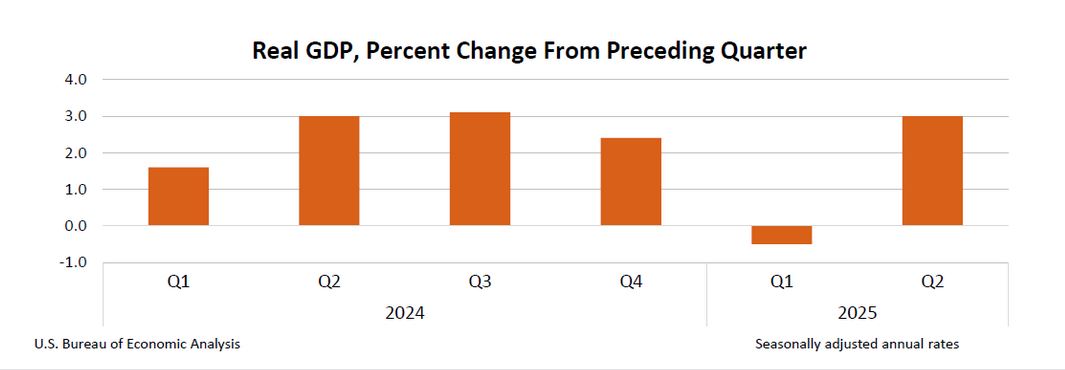Real gross domestic product (GDP) increased at an annual rate of 3.0% (0.7% quarterly rate) in the second quarter of 2025 (April, May, and June), rebounding from a 0.5% decline in the first quarter, according to the advance estimate released by the U.S. Bureau of Economic Analysis (BEA) on Wednesday.
The first quarter drop in “real” (inflation-adjusted) GDP was largely due to a spike in imports (which reduce GDP) as consumers tried to get ahead of any price increases caused by President Donald Trump’s threat of levying reciprocal tariffs on countries charging exorbitant tariffs on U.S. goods.
Since then, Trump has negotiated trade deals with multiple countries, most recently with the United Kingdom, easing fears of tariff-induced inflation.
The increase in real GDP in the second quarter primarily exceeded economists’ expectations of 2.0% growth and reflected both a decrease in the negative impact of imports and an increase in consumer spending. Decreases in investment and exports partially held back GDP growth.
Imports increased by 37.9% in the first quarter, then decreased 30.3% in the second quarter.
Real final sales to private domestic purchasers (consumer spending plus gross private fixed investment) increased 1.2% in the second quarter, compared to a 1.9% first quarter gain.
Meanwhile, the rise in the price index for gross domestic purchases slowed to 1.9%, down from 3.4% in the first quarter. The personal consumption expenditures (PCE) price index also increased at a slower rate (2.1%, down from 3.7%).
Excluding the volatile food and energy components, the so-called “core” PCE price index increased 2.5%, compared with an increase of 3.5% in the first quarter. Both numbers are above the Federal Reserve’s target rate of 2.0%, decreasing the prospect of the Fed lowering interest rates when it addresses the issue Wednesday afternoon.
Within imports, the decrease primarily reflected a decrease in goods, led by nondurable consumer goods, except food and automotive (mainly medicinal, dental, and pharmaceutical preparations, including vitamins). Within exports, the decrease primarily reflected a decrease in goods, led by automotive vehicles, engines, and parts.
The largest contributor to the decrease in investment was private inventory investment, led by decreases in nondurable goods manufacturing (mainly, chemical manufacturing) and in wholesale trade (reflecting widespread decreases in durable goods industries).
Percent change from Q1 to Q2:
- Real GDP: Up 3.0%
- Current-dollar GDP: Up 5.0%
- Real final sales to private domestic purchasers: Up 1.2%
- Gross domestic purchase price index: Up 1.9%
- PCE price index: Up 2.1%
- PCE price index excluding food and energy: Up 2.5%
The BEA will release an updated estimate for the second quarter on August 28, 2025.
The business and economic reporting of CNSNews is funded in part with a gift made in memory of Dr. Keith C. Wold.
Photo by: U.S. Bureau of Economic Analysis
